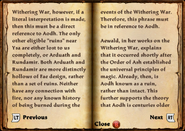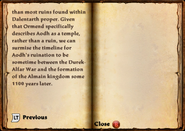Description[]
This plain, leather bound volume bears the initials V.C.
Contents[]
Aodh: The Mythos of Mayhem By Valfillian Carr
Introduction
Fire; that essence which invigorates the imagination of the mind, yet stifles the growth of the natural. It is both a weapon and a tool, a source of fascination to all people. Who can help but be mesmerized by the intricacies within a dancing flame? From this single element sparks the spirit of life. For ages, few have understood its potential, and fewer still have mastered the art of controlling its starved nature. Yet there is a place in the Faelands, where it is not only studied, but worshipped; for within Aodh, there exists an especial connection to this otherworldly power. Indisputably, Aodh is the prime nexus of the living flame.
In this volume, I will give a brief history of the legendary sanctum and elucidate the mystery surrounding this ruin.
Part 1 - The Mythos
The beginnings of Aodh are shrouded by the darkness of ages past. According to legend, the temple was a place of communion with Vraekor, the God of Fire. Before the coming of the Architect, the Sidhe was a panoply of disparate elemental energies. When the Architect first came upon the Sidhe, he was nearly consumed by a magical, wild inferno. He sought to quell the raging fire, and diverted the waters of the Sidhe so that they would fall upon the inferno. With the flames extinguished, he could see the inferno was actually a sanctum of fire. The tale ends with the Architect then turning to shape the rest of the SIdhe.
The earliest recorded mention of Aodh comes from the histories of the Durek-Alfar War. According to the Dokkalfar historian Ormend, during the Durek invasion of Alfar lands, a portion of the Durek army came across a "glowing temple carved from stone at the foot of a waterfall." The Durek contingent, being a "warlike and foolhardy tribe" entered and disappeared within the depths of the temple. It is possible that the glowing temple in question was any number of ruins found throughout Dalentarth, however, earlier, when writing of the Durek army's route, Ormend describes their trespassing of a sacred Fae place: "an enormous tree, unlike any others found within the enchanted Fae forest." This would be Caer Nyralim of the Ring of Keozai, found in the Sidhe, and well within half a league of Aodh.
The next possible mention of Aodh is found in Fae lore, through a verse in the Withering War:
"... and Ysa planted the Gardens after the Storm, and Nurtured the Court of Summer by the Ruins of Fire."
Here we find a reference to "the Ruins of Fire" near Ysa and the Court of Summer. When taken figuratively, it is an obvious reference to the lands destroyed during the Withering War, however, if a literal interpretation is made, then this must be a direct reference to Aodh. The only other eligible "ruins" near Ysa are either lost to us completely, or Arduath and Rundamir. Both Arduath and Rundamir are more distinctly hollows of Fae design, rather than a set of ruins. Neither have any connection with fire, nor any known history of being burned during the events of the Withering War. Therefore, this phrase must be in reference to Aodh.
Aewald, in her works on the Withering War, explains that it occurred shortly after the Order of Ash established the universal principles of magic. Already, then, is Aodh known as a ruin, rather than intact. This further supports the theory that Aodh is centuries older than most ruins found within Dalentarth proper. Given that Ormend specifically describes Aodh as a temple, rather than a ruin, we can surmise the timeline for Aodh's ruination to be sometime between the Durek-Alfar War and the formation of the Almain kingdom some 1100 years later.






